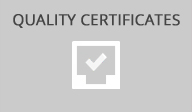Coaxial Cables
What is Coaxial Cable?
Coaxial cable, or coax cable, is an electrical cable which transmits radio frequency (RF) signals from one point to another. It generally consists an inner conductor, a dielectric (insulating material) layer surrounded by one or more concentric conducting shield and a protective outer sheath or jacket. The term coaxial refers to the inner conductor and the outer shield sharing a geometric axis.
Coaxial cable is a type of transmission line, used to carry high-frequency electrical signals with low losses. It is used in such applications as telephone trunk lines, broadband internet networking cables, high-speed computer data busses, cable television signals, and connecting radio transmitters and receivers to their antennas.
What is RG?
There are different types of coaxial cable, which vary by gauge and impedance. Gauge refers to the cable’s thickness and is measured by the radio guide measurement or RG number were specified for military uses. The current military standard is MIL-SPEC MIL-C-17.
What is Coaxial Cable used for?
Coaxial cables are the best solution of their shielded design allows the centre conductor to transmit data quickly while being protected from damage and interference.
Coaxial cable works by carrying data in the centre conductor. In the main, the copper is used as a centre conductor at Erse Kablo.
The dielectric layer provides distance between the conductor and the outer layers, as well as insulation. Generally, it’s made from solid or foam polyethylene polymer.
The next layer, the shield or screen, keep electrical impulses and radio transmissions out as any signal loss (attenuation loss) and help reduce electromagnetic interference.
What is screening efficiency (electromagnetic performance)?
The fact that the signals carried in coaxial cables are not distorted and protected against external interference depends on the high shielding. The efficiency of the shielding varies depending on the material, structure and coverage ratio of the metal-foil and braiding.
Screening efficiency of coaxial cables is determined by measuring screening attenuation and transfer impedance. Tests on screening efficiency is performed in Erse test laboratory using the Triaxial test method, able to provide accurate and reliable data according to EN50289-1-6. Based on result of screening attenuation and transfer impedance values, screening class is determined as C, B, A, A+ and A++ from lower to higher performance according to EN 50117 standard series.
As Erse Kablo, we are manufacturing best coaxial cables with wide range according to related standards.
Coaxial Cable Length
In radio systems, coaxial cable length is comparable to the wavelength of the signals transmitted. Characteristics of the cable, such and outside diameter of the inner conductor, inside diameter of the shield, dielectric contact of the insulator and magnetic permeability of the insulator all affect the quality of the wavelength going through your cable.
The Points to Consider in Coaxial Cable Selection
First, check the ohms, impedance, screening class and connections.
Next, calculate how far you need to go between your devices or from the source of your power to the device.
The loss that is acceptable will depend on your devices and your application. To minimize the loss, the source and load impedances must be correct.
Erse’s Coaxial Cable Solutions for the Customer Expectations
It carries out successfully the product and quality-oriented studies by following innovations. Best coaxial cable has been its shielded design, which allows the cable's copper core to transmit data quickly.
Erse has national and international standards for coaxial cables, total quality consciousness are taken into consideration at every stage in manufacturing and technical training that is organized in order to provide sustainable quality, improve the quality system.
Erse’s target is to be an effective player in the global market by carrying on the leadership position in domestic market for coaxial cables.
Erse is a firm which does not compromise on quality for coaxial cables; it closely follows technological developments along with being an innovative and environmentally-conscious firm, and it adds value to its solution partners with its customer-focused approach.
Our coaxial cables are produced for optimal use in high-frequency. We focus on achieving the best possible electrical values. It is used as a distribution cable for indoor CATV, CCTV systems and as a connection cable for satellite systems where lower attenuation is required. Coaxial cables which have HFFR sheathing are used in places where people are densely populated (such as shopping centers, hotels etc.) and places in which it is required that there is no smoke and corrosive gases emitted by fire which threats to human health.
We are at your disposal for your demands; you could have best coaxial cable price from our export sales team and our technical team would be pleased to answer your questions about technical points. We will be happy to advise you on our product range and the possible applications of Erse’s coaxial cables. You can contact us with e-mail or head office’s telephone numbers.










































